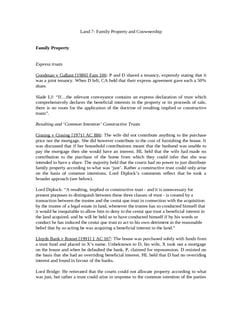Wheeldon v Burrows [1879] 12 Ch D 31
Judgement for the case Wheeldon v Burrows
KEY POINTS
For an easement to be implied from a quasi-easement, the following requisites must concur:
Must be continuous and be apparent at the time of the sale;
Must be necessary for the reasonable use and enjoyment of the property; and
Must have been enjoyed by the vendor when he owned both the dominant and servient lots.
FACTS
The property in question had originally been owned by a man named Allen in the mid-19th century. Allen acquired two adjoining tenements, with one of them separated from the other by a wall. Over time, he made alterations to one of the tenements, including building a shed with windows adjacent to the wall.
In 1875, Samuel Tetley owned both of these tenements and decided to sell them. The lot that included the modified shed with windows was purchased by William Wheeldon at an auction while the other was bought by W.T.B. Burrows.
Afterwards, the plaintiff’s wife erected barriers near the windows of Burrows' shed, claiming her right to the unobstructed use and possession of her land. In response, Burrows dismantled her construction, asserting his right to an easement of light through the shed's windows.
Thus, Wheeldon brought a suit against Burrows for trespass.
JUDGEMENT
Appeal dismissed.
COMMENTARY
This case is crucial, especially in property law, as it offers a framework for figuring out the rights and obligations of parties during the subdivision and sale of property. As long as the parameters indicated in the doctrine are followed, it helps ensure that the new property owners have access to necessary easements without the need for formal agreements or talks.
ORIGINAL ANALYSIS
X owned 2 plots of land, one of which had a quasi-easement of light over the other. He then sold quasi dominant plot to Plaintiff after selling the quasi-servient one to Defendant.
CA held that Plaintiff did not have an easement because the servient land had been sold first, NOT subject to any easements, servitudes, etc.
Had the dominant one been sold first then there would have been an easement.
Thesiger LJ
-
There are 4 aspects to the rule:
Firstly there had to have been a quasi-easement
Secondly the dominant land has to have been sold first
Thirdly the quasi-easement had to have been continuous and apparent
Fourthly the easement must be necessary for the reasonable enjoyment of the land.
RELATED CASES
For Further Study on Wheeldon v Burrows
Need instant answers? Our AI exam tutor is here to help.
Ask questions 🙋 Get answers 📔 It's simple 👁️👄👁️
Our AI is educated by the highest scoring students across all subjects and schools. Join hundreds of your peers today.
Get StartedSimilar Cases
Related Product Samples
These product samples contain the same concepts we cover in this case.
| Land Law | Easements Notes (48 pages) |

 Since 2010, Oxbridge Notes has been a trusted education marketplace, supplying high-quality materials from top achievers at universities like Oxford, Cambridge, LSE, Harvard, and Yale.
Since 2010, Oxbridge Notes has been a trusted education marketplace, supplying high-quality materials from top achievers at universities like Oxford, Cambridge, LSE, Harvard, and Yale.